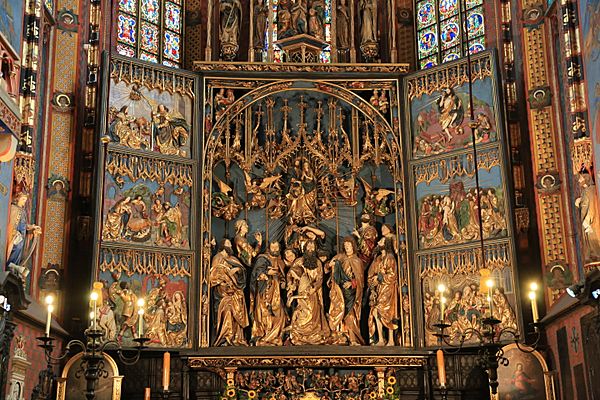Veit Stoss facts for kids
Quick facts for kids
Veit Stoss
|
|
|---|---|
 |
|
| Born | Before 1450 |
| Died | 20 September 1533 |
| Resting place | St. Johannis cemetery, Nuremberg |
| Known for | Sculpture |
| Movement | Late Gothic, Northern Renaissance |


Veit Stoss (also known as Veit Stoß or Wit Stwosz in Polish) was a very important German sculptor. He lived from before 1450 until about 1533. He mostly worked with wood. His career happened during a time when art was changing from the late Gothic style to the Northern Renaissance.
Stoss was known for making sculptures that showed a lot of feeling and emotion. He was very skilled at carving flowing clothes in his art. Some people even called his style "late Gothic Baroque" because it was so dramatic. He had a big workshop with many helpers. His most famous work is the large altarpiece in St. Mary's Basilica in Kraków, Poland.
Contents
Veit Stoss's Life Story
Veit Stoss was born in a place called Horb, likely Horb am Neckar in Germany. However, some clues suggest he might have learned his art skills in modern Switzerland. His brother was born in Aarau, Switzerland, which makes some people think his family lived in that area.
We don't know his exact birthday, but it was just before 1450. We don't know much about his early life until 1473. In that year, he moved to Nuremberg in Franconia, Germany, and married Barbara Hertz. Their oldest son, Andreas, was born there.
Moving to Kraków
Before 1477, Stoss moved to Kraków, which was the royal capital of Poland at the time. He was asked to create a huge, colorful wooden altarpiece for St Mary's Church in Kraków. This altarpiece became known as the Altar of Veit Stoss. His son Stanisław also became a sculptor. Veit Stoss lived and worked in Kraków for the next twenty years. In Poland, his name is often said as Wit Stwosz.
His Work in Kraków
The famous altar in Kraków was finished in 1489. It was the largest triptych (a three-part artwork) of its time. Like his other big projects, it needed a large workshop. This included special painters and gilders (people who apply gold leaf).
Other important artworks Stoss made in Poland include the tomb of King Casimir IV in Wawel Cathedral. He also made the marble tomb of Zbigniew Oleśnicki in Gniezno. The Polish royal court was more familiar with Italian art styles than people in Nuremberg at that time. Because of this, some of Stoss's work in Poland used Renaissance-style decorations.
The Altar During World War II
During World War II, the altarpiece was taken apart and sent to Nazi Germany around 1941. This happened because of orders from the German governor of occupied Poland. In 1945, it was found again in Bavaria, hidden in the basement of the heavily bombed Nuremberg Castle. The High Altar was brought back to Poland. It went through a lot of repair work and was put back in its place at the Basilica ten years later.
Returning to Nuremberg
In 1496, Stoss moved back to Nuremberg with his wife and eight children. He paid money to get his citizenship back and started working as a sculptor there again.
Between 1500 and 1503, he carved an altar for a church in Schwaz, Tyrol. This altar is now lost. In 1503, he faced serious trouble. He was accused of using a fake seal and signature for a dishonest business deal. He was punished and not allowed to leave Nuremberg without permission from the city council. However, in 1506, Emperor Maximilian forgave him and gave him back his full rights as a citizen.
Even though he was told not to leave, he went to Münnerstadt in 1504. There, he painted and gilded an altarpiece that another sculptor, Tilman Riemenschneider, had left as plain wood. Stoss's workshop included painters, which was not common for all sculptors at that time.
He also created an altar for Bamberg Cathedral and other sculptures in Nuremberg. These include the Annunciation and Tobias and the Angel. In 1506, he was arrested again. In 1507, Emperor Maximilian wrote a letter to pardon him. The Emperor argued that Stoss should be forgiven because he was such a talented artist. The city council of Nuremberg still did not fully support him, but the Emperor's help saved him from very severe punishment.
He was able to stay in Nuremberg from 1506, but the council did not give him many big projects after that. In 1512, the Emperor asked Stoss to help plan his tomb monument. This monument was later placed in the Hofkirche in Innsbruck.
Later Works
Between 1515 and 1520, Veit Stoss was hired by Raffaele Torrigiani, a wealthy merchant from Florence. In 1516, Stoss made Tobias and the Angel (now in the Germanisches Nationalmuseum, Nuremberg). He also made a statue of Saint Roch for the Basilica of Santissima Annunziata in Florence. This wooden statue shows the saint as a traveler, lifting his clothes to show a mark on his leg. Even a famous art historian named Giorgio Vasari praised this statue. He called it "a miracle in wood," even though he sometimes got the artist wrong.
Veit Stoss was buried at St. Johannis cemetery in Nuremberg. His son Stanisław continued his artistic work.
See also
 In Spanish: Veit Stoss para niños
In Spanish: Veit Stoss para niños



